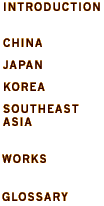
![]()
Glossary
BODIES
- Earthenware
- A relatively soft, semiporous ceramic using clays fired to temperatures between 600 and 1150 degrees Celsius. In north China, deep deposits of rock dust rich in mica and silica known as loess were used for earthenwares.
Stoneware- A hard ceramic impervious to water and fired at between 1150 and 1280 degrees Celsius. Often but not always glazed.
Porcelain- A white translucent ceramic, usually glazed, fired to a temperature of 1280 degrees Celsius or higher. Various materials were used to make porcelain. In north China kaolin (a pure type of clay) was used, but in south China crushed porcelain stone (a volcanic rock rich in quartz) was sometimes the primary material, with additions of kaolin.
GLAZE
- Glaze (high-fired)
- A solution of ashes or crushed rocks high in silica and fluxes (a metallic oxide which lowers the melting point of the other constituents) applied to the body of a ceramic before firing. In high-fired glazes the outer layer of the body and glaze fuse together during firing. The earliest high-fired glazes were produced accidentally as ash flying through the kiln reacted with the body of the ceramic. Glazes can be colored with metallic pigments such as iron, copper, and cobalt.
Glaze (low-fired)- Low-fired glazes in East Asia were usually fluxed with lead, which has the additional property of producing bright colors in combination with other metal oxides. Lead glazes could be applied directly to the body as in funerary wares or applied with a brush as a medium for painted decoration over a high-fired glaze. In the latter case the term enamel is applied to the low-fired glaze. Two firings were required, one for the body and high-fired glaze, and a second, lower one for the lead glaze.
Celadons- A name taken from a character in a seventeenth-century French play who dressed in green and applied to imported Chinese green-glazed stonewares and porcelains popular in France at that time.
PIGMENT
- Metallic oxides
- These lend color to glazes depending on their concentration and firing conditions or are used as pigments directly on the body.
Iron- Frequently used in high-fired glazes. In small concentrations and a reducting atmosphere, it will yield bluish-green. In high concentrations it yields a dark brown or black. In overglaze enamels it can yield a flame red or in combination with antimony, a brilliant yellow. Painted directly on the body, it can yield a black or brown.
Copper- Used in lead-fluxed glazes, produces a bright green. As a pigment applied to the body under transparent high-fired glazes in reducing conditions it could produce red, but difficult to control.
Cobalt- Cobalt yields a rich blue. It was first applied to ceramics in western Asia and was used in China during the Tang dynasty (618-906) as a glaze colorant. It reappears in China during the 14th century as a pigment applied to porcelain under a colorless glaze, a combination popularly known in the West as "blue-and-white."
FIRING
- Reduction and Oxidization
- This refers to the amount of oxygen allowed in the kiln. Reduction is produced by a carbon-rich atmosphere from which oxygen is limited, while oxidization allows a generous amount of oxygen to enter the kiln. Reduction and oxidization affect the color of bodies, glazes, and pigments.